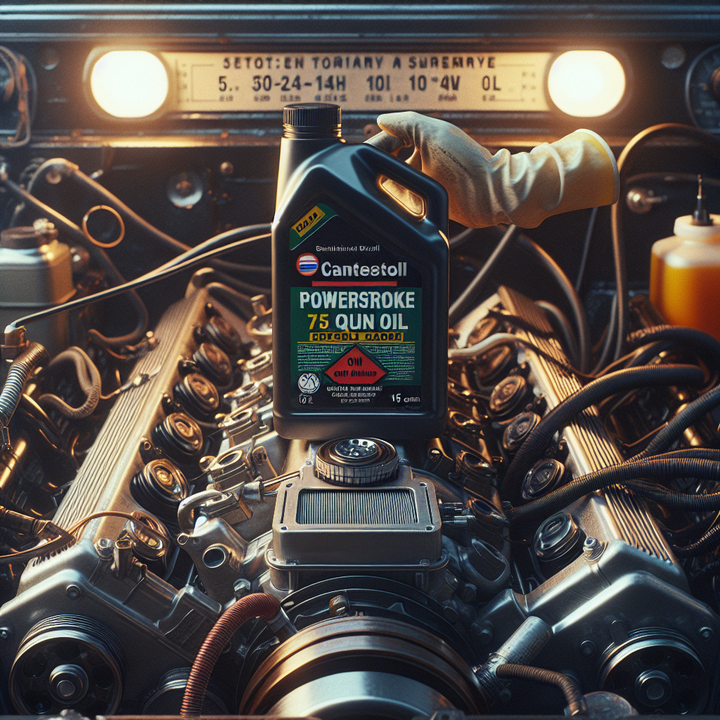


As a diesel engine owner, maintaining proper oil levels and performing timely oil changes are crucial for ensuring the longevity and optimal performance of your vehicle. The Ford 7.3L Powerstroke diesel engine, renowned for its durability and power, requires meticulous care to keep it running smoothly. This comprehensive guide will delve into the oil capacity, recommended oil types, change procedures, common leak areas, and maintenance intervals specific to the 7.3L Powerstroke engine. Whether you're a seasoned mechanic or a DIY enthusiast, this article will equip you with the knowledge and expert advice necessary to maintain your heavy-duty truck effectively.

Proper oil maintenance is vital for any engine, but it's especially crucial for diesel powerplants like the 7.3L Powerstroke. These robust engines endure immense stress and generate substantial heat, making regular oil changes and the use of high-quality lubricants essential for optimal performance and longevity. The 7.3L Powerstroke, found in Ford's Super Duty trucks like the F-250, F-350, and Excursion, was produced from 1994 to 2003 and has earned a reputation for reliability and durability when properly maintained.
The 7.3L Powerstroke engine has an oil capacity of 15 quarts or 14.2 liters, including the oil filter capacity. This oil capacity applies to all model years of the 7.3L Powerstroke, ensuring consistent maintenance requirements across the entire production run.
Ford recommends using a 15W-40 diesel engine oil that meets the WSS-M2C171-F1 specification for the 7.3L Powerstroke. This viscosity grade strikes a balance between cold-weather pumpability and high-temperature protection, ensuring optimal lubrication under various operating conditions.
| Oil Type | Viscosity | Description |
|---|---|---|
| 15W-40 Diesel Engine Oil | 15W-40 | The recommended oil type for the 7.3L Powerstroke. The "W" stands for "winter," indicating good low-temperature flow, while the "40" denotes high-temperature protection. |
| 5W-40 Synthetic Diesel Oil | 5W-40 | Some owners opt for this lower viscosity synthetic oil in extremely cold climates for improved cold-weather starting and oil flow. |
Several reputable brands offer oils that meet the WSS-M2C171-F1 specification, including:
Motorcraft
Rotella
Mobil
Shell
Valvoline
These high-quality synthetic or synthetic-blend diesel oils are specifically formulated to meet the demanding requirements of diesel engines like the 7.3L Powerstroke.
While conventional mineral-based oils can be used in the 7.3L Powerstroke, many owners opt for synthetic or synthetic-blend oils due to their superior performance and extended drain intervals. Synthetic oils offer better oxidation resistance, improved low-temperature flow, and enhanced protection against sludge and deposit formation.
Changing the oil in your 7.3L Powerstroke is a straightforward process that can be performed by most DIY enthusiasts with the right tools and knowledge. Following the proper procedure is essential to ensure a thorough oil change and prevent any potential issues.
Before beginning the oil change process, it's crucial to warm up the engine to ensure the oil drains more efficiently. Gather the necessary tools and supplies, including:
Drain pan
Wrenches or sockets
New oil filter
Recommended quantity of fresh oil
The oil change procedure for the 7.3L Powerstroke involves several steps:
Draining the old oil
Locate the drain plug, typically situated on the bottom of the oil pan, and place a drain pan underneath.
Using the appropriate wrench or socket, loosen and remove the drain plug to allow the old oil to drain completely.
Replacing the oil filter
Once the oil has drained, locate the oil filter, which is typically accessible from the top of the engine.
Use an oil filter wrench to remove the old filter.
Before installing the new filter, apply a thin coat of fresh oil to the gasket to ensure a proper seal.
Fill the new filter with clean oil, approximately 2/3 full.
Install the new filter by hand-tightening only, being careful not to over-tighten.
Refilling with fresh oil
Unscrew the oil fill cap and pour in approximately 13 quarts of fresh oil through the fill tube.
Start the engine and allow it to idle for a minute, then shut it off and wait a few minutes for the oil to drain into the oil pan.
Checking the oil level
After refilling, check the dipstick and add more oil until the level reaches the full mark, being careful not to overfill, as this can cause potential issues.
It's essential to use a high-quality oil filter designed specifically for the 7.3L Powerstroke engine. Popular choices include:
| Oil Filter | Description |
|---|---|
| Motorcraft FL1995 | A standard oil filter designed for the 7.3L Powerstroke. |
| Donaldson DBL7405 | A larger filter that offers increased capacity for extended oil change intervals. |
Over time, the 7.3L Powerstroke engine may develop oil leaks, particularly in high-mileage engines. Being aware of the common leak areas can help you identify and address potential issues promptly.
High-Pressure Oil Pump (HPOP): The HPOP and its associated o-rings and seals are frequent sources of oil leaks in the 7.3L Powerstroke. Leaks from this area can result in oil accumulation in the valley between the cylinder heads.
Valve Covers: Deteriorated valve cover gaskets can allow oil to seep into the valley area, leading to potential engine contamination and other issues.
Rear Main Seal: A leaking rear main seal can cause oil to drip from the back of the engine, near the transmission bell housing. This can be a messy and potentially costly issue if left unaddressed.
Turbo Pedestal: The turbo pedestal and exhaust back pressure (EBP) valve can develop leaks over time, leading to oil accumulation at the rear of the valley.
Oil Cooler Gaskets: Leaks from the oil cooler gaskets or fittings can cause oil to drip near the oil filter housing, potentially leading to contamination or other issues.
Regularly inspecting these areas and replacing worn seals, gaskets, and components can help prevent or fix oil leaks in the 7.3L Powerstroke engine.
Adhering to the recommended oil change intervals is crucial for maintaining the health and longevity of your 7.3L Powerstroke engine.

Ford recommends changing the oil and filter in the 7.3L Powerstroke every 7,500 miles or 6 months, whichever comes first, under normal driving conditions.
However, many owners opt for more frequent changes, such as every 5,000 miles, especially for engines used in severe service or towing applications. Severe service conditions include:
Frequent towing
Hauling heavy loads
Idling for extended periods
Operating in extreme temperatures
Driving in dusty environments
Cold weather can pose additional challenges for diesel engines, and the 7.3L Powerstroke is no exception. To ensure optimal performance and protection during the winter months, some adjustments to your oil selection may be necessary.
While the recommended 15W-40 viscosity is suitable for most climates, some owners recommend using a 5W-40 synthetic diesel oil, such as Rotella T6, for improved cold-weather starting and oil flow in extremely cold temperatures.
The lower viscosity of a 5W-40 oil allows for better pumpability and easier engine cranking in sub-freezing conditions, reducing the strain on the starter and battery.
Proper oil maintenance is just one aspect of ensuring the longevity and reliability of your 7.3L Powerstroke engine. Several other factors contribute to the overall health and performance of your vehicle.
Following manufacturer recommendations: Adhering to Ford's recommended maintenance schedules, including oil changes, fluid flushes, and other service intervals, is crucial for keeping your 7.3L Powerstroke in top condition.
Addressing oil leaks promptly: Oil leaks can be a common issue with high-mileage 7.3L Powerstroke engines. Promptly addressing any leaks by replacing worn seals, gaskets, or components can prevent further damage and costly repairs down the line.
Using high-quality oils and filters: Investing in high-quality oils and filters specifically designed for the 7.3L Powerstroke can go a long way in protecting your engine from wear, sludge buildup, and other issues. Cheap, low-quality products may save you money in the short term but can lead to costly repairs or premature engine failure.
Maintaining the proper oil level and performing timely oil changes are essential for ensuring the longevity and optimal performance of your Ford 7.3L Powerstroke diesel engine. By following the recommended oil capacity, using the correct oil type and viscosity, adhering to the change intervals, and addressing any potential leak areas, you can keep your heavy-duty truck running smoothly for years to come. Remember, investing in high-quality oils, filters, and regular maintenance is crucial for protecting your investment and maximizing the lifespan of your 7.3L Powerstroke engine.
Based on the comprehensive article, here is an FAQ section with 10 additional questions and answers:
Ford recommends changing the oil and filter every 7,500 miles or 6 months, whichever comes first, under normal driving conditions. For severe service conditions like frequent towing or hauling heavy loads, more frequent oil changes around 5,000 miles are advisable.
While conventional oils can be used, many owners prefer synthetic or synthetic-blend oils due to their superior performance, oxidation resistance, and extended drain intervals.
Common leak areas include the high-pressure oil pump (HPOP), valve covers, rear main seal, turbo pedestal, and oil cooler gaskets.
After refilling with approximately 13 quarts of fresh oil, start the engine, let it idle for a minute, shut it off, and wait a few minutes for the oil to drain into the oil pan. Then, check the dipstick and add more oil until it reaches the full mark.
The 7.3L Powerstroke engine has an oil capacity of 15 quarts or 14.2 liters, including the oil filter capacity.
Yes, some owners recommend using a 5W-40 synthetic diesel oil, such as Rotella T6, for improved cold-weather starting and oil flow in extremely cold temperatures.
Popular choices include the Motorcraft FL1995 standard filter and the larger Donaldson DBL7405 filter, which offers increased capacity for extended oil change intervals.
It's essential to properly dispose of used oil and filters at designated recycling centers or facilities to prevent environmental contamination.
While it's possible to change the oil yourself, it's generally recommended to have it done by professionals who have the proper tools, knowledge, and experience to ensure the job is done correctly and safely.
Signs of an oil leak can include oil drips or puddles under the vehicle, low oil levels, or the presence of oil in the engine valley or other areas of the engine bay.

Sarah isn't your average gearhead. With a double major in Mechanical Engineering and Automotive Technology, she dived straight into the world of car repair. After 15 years of turning wrenches at dealerships and independent shops, Sarah joined MICDOT to share her expertise and passion for making cars run like new. Her in-depth knowledge and knack for explaining complex issues in simple terms make her a valuable asset to our team.



